





PHOTO GALLERY

Photos by Len Blumin
1. Osprey with young
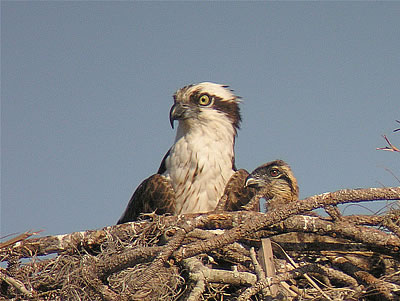
Osprey, aka "Fish Hawk", build large stick nests on exposed snags or platforms, often re-using last year's nest and adding some sticks, like eagles, herons, etc. They lay 2-4 eggs, often 3. The female does most of the incubation (70% or more) and after hatching she spends almost all her time on the nest, while the male forages for fish to feed his mate and the nestlings. The young fledge only after 50 days, so he keeps busy. The male Opsrey is smaller by up to 25%, so sex of adults is easy to distinguish when they are together. The female usually has a necklace of dark streaks on the upper breast, but some males have similar markings. One of the easiest ways to distinguish is by the nesting activity mentioned, as the male will be seen on a feeding perch near the nest, while the female watches over the young, as here. Three young were there when we arrived, but only two were seen five days later.
Osprey are extremely vocal - their loud screaming calls can be heard at quite a distance. They are also ferocious in defending their nests. Last year we saw this bird chasing an adult Bald Eagle from the area. Lest anyone think I am getting too close for this shot, the next photo shows the nest and feeding perch taken from the same spot where I digi-scoped this female with young.
References: BNA, Ency. NA Birds (Terres), Kaufman (Lives of NA Birds)
2. Osprey nest at true distance

I removed the camera from the scope and snapped a shot of the nest with the zoom at the same setting, so the difference between the nest photo and the shot below is due to the 30X magnification of the scope, plus some additional magnification from cropping the image of the nest (by 50-60%). The birds are aware of my presence but are quite oblivious, as I suppose they know their perches are quite safe. The male is barely seen on his feeding perch below and to the right of the nest platform pole, just above the foliage.
If you would like to see exactly where this photo was taken, check out my Flicker site at http://www.flickr.com/photos/lenblumin/. Just below the photo there is a link to "map", which will take you to a Google map where the location can be seen either or a regular street map of a hybrid map, both of which can be zoomed for detail. This allows a photo to be placed within about 20 feet of where it was taken. Cool!
Forgot to mention that there are four sub-species of Osprey worldwide, with ours named Pandion halliaetus carolinensis. All are quite similar.
3. Cape May Warbler - Dendroica tigrina
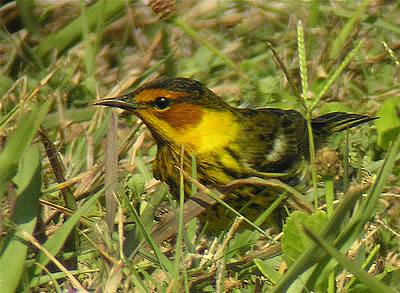
Not often that we see breeding plumage warblers in the scope for long, much less get time to take a photo! Just before leaving Florida we went to Ft. de Soto Park, just south of St. Petersburg on the Gulf Coast. We met a friend at the visitor center and witnessed a mini "fall-out" of late migrants stopping to replenish their energy stores. The lawn nearby was covered with warblers, hopping about in chase of crickets and smaller prey. My favorite was the Cape May Warbler. This male was more rufous than most, his strong colors showing well despite intense sunlight.
Taxonomy (see Kimball Garrett's account in the Sibley Guide to Bird Life and behavior)
Order: Passeriformes - Perching birds
Family: Parulidae - The Wood Warblers (distinguished from Old World Warblers). Insectivores, mostly with small bills, and many of the males brightly colored. 116 species, of which 53 are seen in the U.S.
Genus: Dendroica - It means "tree-dwelling", as we of warbler-neck pain know all too well. Big genus, with 27 species, 21 of which can be seen in the U.S. Some of those we see regularly out west include Yellow, Yellow-rumped, Black-throated Gray, and Hermit Warblers. Others are seen as vagrants, especially in the fall at sites like Pt. Reyes (Outer Point).
Species: Dendroica tigrina - Cape May Warbler. They breed in far northern U.S. and across Canada. "tigrina" said to refer to the tiger stripes on the breast, barely seen here.
4. Black-bellied Plover male - Pluvialis squatarola
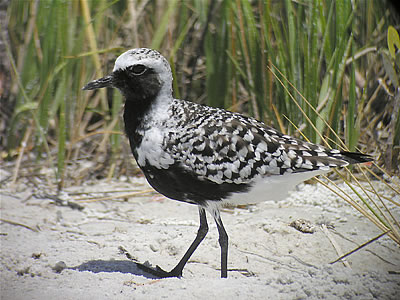
The Black-bellied Plover is a bird that will head to tundra, arriving late May. The Black-bellied is seen pretty much world wide, and doesn't vary a lot (no recognized subspecies). Sticks pretty much to the coasts, whereas the Golden Plovers can be seen further inland. I didn't recall that in breeding plumage the male and female differ a bit, with the male showing more black. Black-bellied is the largest of the Pluvialis, and has a heavier bill. Also has clean white undertail marking, and in flight shows black axillaries ("wingpits"). The cap of the Black-bellied is usually shown as lighter in color than on the Golden Plovers. I think Paulson's "Shorebirds" explains the field marks better than O'Brien's "Shorebird Guide", and both are better than the Sibley Guide. Also prefer the National Geo field guide to Sibley for the plovers. The Black-bellied is pretty much pure salt and pepper on the back, whereas the Golden Plovers will show a bit of color.
Taken 4/29/09, Ft. De Soto Park, North Beach. It was too hot there even for mad dogs and Englishmen, but we enjoyed it immensely. Photo shows the large bill, light cap, lack of gold color in back, and clean white under the tail.
5. Blackpoll Warbler - Dendroica striata
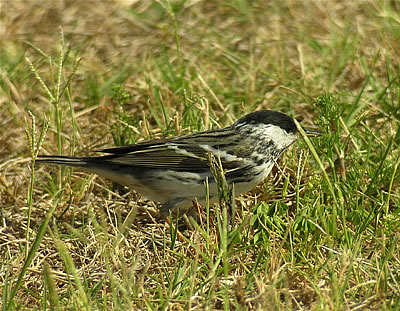
The male Blackpoll Warbler in breeding plumage is pretty bird, with a complete dark cap that goes down to the eye, kind of like a Western Grebe (groan), and a clean white cheek. This was one of the flock of warblers on the lawn at Ft. De Soto Park April 29. We see a duller version sometimes at the Outer Point in the fall, but none have been reported thus far locally as a spring vagrant. These guys can fly! Kaufmann (Lives of NA Birds) reports that in fall they leave from the coast in NE U.S. and fly directly to northern South America in a nonstop flight of 72+ hours. They breed all across the northern forests of Canada. They eat insects and berries, and some seeds. The male is quite different from the female.
P.s. Blackpoll means "black head", referring to the black cap.
6. Peregrine Fledglings at the Lighthouse
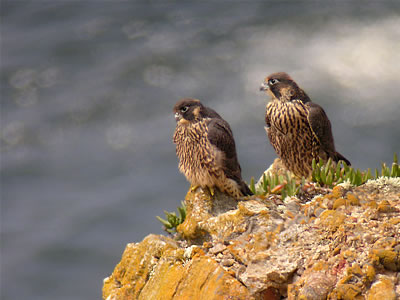
Photo taken from the walk out to the lighthouse viewing platform, distance to birds about 85 yards.
7. Red-bellied Woodpecker - male - Melanerpes carolinus
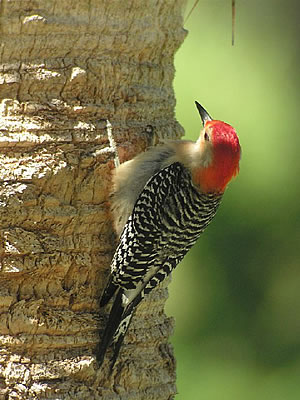
The male has worked his way up a palm tree, and gives a nice view of the full extent of the red from lower nape all the way to the forehead. The Red-bellied Woodpecker has a very varied diet, that includes the usual insects, but also fruits, berries and small vertebrates. This shot also show the black spots on the white rump patch. The Golden-fronted Woodpecker has a clean white rump patch.
8. Calliope Hummingbird - Stellula calliope
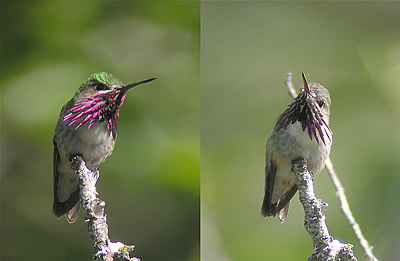
The Calliope Hummingbird (Stellula calliope) is occasionally seen in the Bay Area, but more often sighted at higher elevations, where it breeds in the western montane forests well up into Canada. "Calliope" is the name of the Greek muse of epic poetry, and all the muses were said to be comely, like our hummers. "Stellula" mean "little star", certainly an apt description of our smallest hummingbird, and the smallest bird breeding in the U.S. See BNA #135 (WA and LL Calder) for more details.
Migration is not easy for tiny birds, and the Calliope in fact is said to be the smallest "long-distance migrant" in the world. When it travels from Canada to its wintering grounds in Mexico it racks up some 9000 km per year!
These photos (taken from 30' distance) of the same bird show the amazing gorget which is divided into distinct rays, quite unlike other U.S. hummingbirds. We watched these delightful creatures from the roadside above Ashland, OR, on a GGAS trip led by Harry Fuller in May. They've already headed back to Mexico by now.
9. Yellow-headed Blackbird - Xanthocephalous xanthocephalous
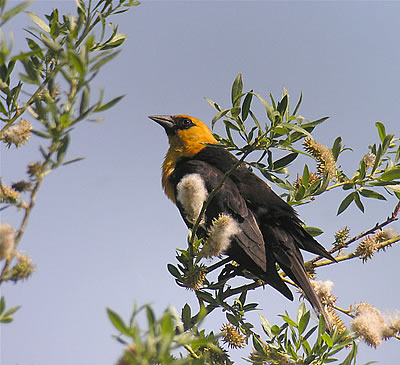
There's no mistaking the male Yellow-headed Blackbird (Xanthocephalous xanthocephalous). We see them rarely in the Bay Area, but a short trip to the Central Valley (e.g. Yolo Bypass) will give them up, or better still go to Sierra Valley north of Lake Tahoe in late spring. Bird shown here is from our Ashland trip in May, where we saw and HEARD many in the marshes of Klamath Lake, OR.
The Yellow-headed male goes north earlier in the spring, most having wintered in Mexico, and establishes a territory in emergent fresh-water vegetation, where the water is at least 2-4' deep, habitat a bit deeper than that preferred by Red-winged Blackbirds. If the Red-winged cousins are present, the more aggressive Yellow-heads will drive them out. The male Yellowhead, like the Redwing, tries to attract multiple mates (polygyny), and often succeeds. In winter the Yellow-headed Blackbirds may join large mixed flocks of blackbirds. These birds usually forage on the ground, so it was nice to see one up in a Willow.
Sibley (Guide) writes: "Song extremely harsh; unmusical; a few hard clacking notes on different pitches followed by wavering raucous wail like a chainsaw." Hmmm. Could any bird really sing that "badly"? Better see what others have to say.
Kaufman (Lives of North Amer. Birds): "It may have the worst song of any North American bird". A "hoarse, hard scraping". Oooh, that hurts.
Teres (Enclyl. of NA Birds): "Male sings cacaphonous series of high- pitched liquid and clacking notes." Hey, "liquid" is good....
Hoffman (Birds of the Pacific States, 1927): "...uncouth cries of the Yellow-headed Blackbirds, suggesting often the drawl of a discontented hen." Guess folks back then knew well the sound of upset hens.
And William Leon Dawson (Birds of California,1923) devotes more than a page to the Yellow-headed male vocalizations. Some snippets include (you gotta love this guy Dawson):
"Verily, if love affected us all in similar fashion (referring to the YH's song), the world would be a merry mad-house".
"Grasping a reed firmly in both fists, he leans forward, and, after premonitory gulps and gasps, succeeds in pressing out a wail of despairing agony which would do credit to a dying catamount. When you have recovered from the first shock, you strain the eyes in astonishment that a mere bird, in love at that, should give rise to such a cataclysmic sound. But he can it it again, and his neighbor across the way can do as well -- or worse."
TOWHEE.NET: Harry Fuller, 820 NW 19th Street, McMinnville, OR 97128
website@towhee.net